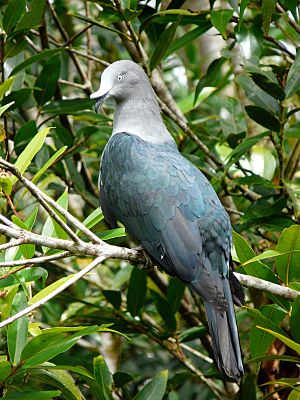Marquesan imperial pigeon facts for kids
Quick facts for kids Marquesan imperial pigeon |
|
|---|---|
 |
|
| Conservation status | |
| Scientific classification | |
| Genus: |
Ducula
|
| Species: |
galeata
|
The Marquesan imperial pigeon (Ducula galeata), also known as the Nukuhiva imperial-pigeon or Upe, is a large pigeon. It lives only on Nuku Hiva island in the Marquesas Islands. These islands are part of French Polynesia in the Pacific Ocean. This special pigeon can only be found in certain valleys on the western side of Nuku Hiva. It is a very rare bird!
Contents
What Does It Look Like?
The Marquesan imperial pigeon is one of the largest pigeons in the world. It weighs about 900 grams (2 pounds). Female pigeons are a bit smaller, measuring 50 to 53.5 centimeters (about 20 to 21 inches) long. Males are slightly larger, at about 55 centimeters (22 inches) long. This bird has a strong body, a big beak, and a long, wide tail. Its wings are wide and rounded.
The pigeon's head, throat, and chest are a dark, sooty-gray color. It has a white band right behind its beak, which makes it easy to spot. Its belly is a bit browner than the rest of its underside. The top parts of its body, wings, and tail are a shiny green with a hint of blue. The underside of its tail and wings are black. Its beak is black, and it has a puffy area above the beak called a cere. This gives its face a unique, sloped look.
This bird makes a deep, cooing sound to attract mates. It sounds like a loud, rumbling "neah-ah, neah-ah" or "naw-aw, naw-naw." Some people even say it sounds a bit like a cow! When it gets excited, it might make a sound like a crow, "krawk, krawk."
Where Does It Live?
This pigeon used to live all over Nuku Hiva island. Back then, most of the island was covered in thick forests. Today, it mostly lives in woodland areas. These woodlands are usually found between 200 and 1500 meters (about 650 to 4,900 feet) above sea level. You might still find a few of these birds in forests near the sea. They can also be seen in woods surrounded by banana and orange farms.
Long ago, before people settled there, this bird also lived on Henderson Island. This island is part of the Pitcairn Islands. We know this because scientists found old bones of the pigeon there.
Life and Habits
You will usually see the Marquesan imperial pigeon alone or in pairs. They often perch in trees that have fruit. These birds are not very shy. They might let you get quite close while they are eating. They love to eat fruits up to 5 centimeters (2 inches) big. Some of their favorite foods include mangos (Mangifera indica) and guavas (Psidium guajava). They also eat many smaller fruits from trees like Ficus, Cordia, and Eugenia.
These pigeons often spend most of the day resting in the tops of trees. They like to be on or near cliffs. When they fly to new places to find food, they flap their wings slowly and with effort over forested hills. When they glide, they hold their wings far back. When they fly down to land, they hold their wings flat against their body.
Reproduction and Life Cycle
Scientists have seen nests in May, July, September, and October. This means that these pigeons might nest almost all year round. Or, they might have their busiest breeding time in the middle of the year.
The parent birds build a flat nest made of sticks. They place it on a tree branch in the forest. The nest is usually high up, about 13 to 20 meters (43 to 66 feet) from the ground. Sometimes, it can be as low as 5 meters (16 feet). The female pigeon lays just one shiny white egg. We do not know much more about how these birds raise their young.
Conservation Status
The Marquesan imperial pigeon is a very rare bird. The IUCN (International Union for Conservation of Nature) first listed it as a critically endangered species. This meant there were thought to be fewer than 150 adult birds left. However, experts later thought there might be more than they first believed.
After checking its numbers again, scientists estimated there were between 150 and 300 birds in total on the island. Because of this, its status was changed in 2008 to Endangered. It is still an extremely rare bird. But, successful efforts to protect it have helped prevent it from becoming extinct for now. It was probably never a very common bird.
Some people used to think this pigeon lived on other Marquesan islands, like the Cook Islands, Society Islands, and Pitcairn Islands. However, most experts now agree that any similar birds found there were likely different types of pigeons in the same Ducula group. The Marquesan imperial pigeon's population has greatly decreased because its forest home has been damaged.


